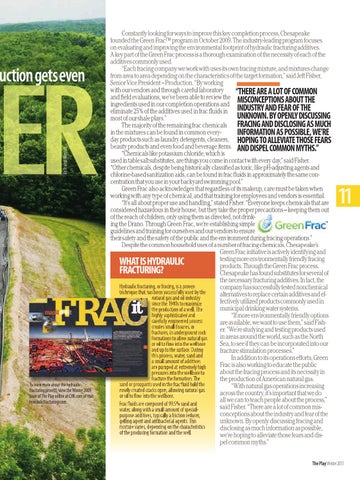NER By Brandi Wessel
uction gets even
Constantly looking for ways to improve this key completion process, Chesapeake founded the Green Frac™ program in October 2009. The industry-leading program focuses on evaluating and improving the environmental footprint of hydraulic fracturing additives. A key part of the Green Frac process is a thorough examination of the necessity of each of the additives commonly used. “Each fracing company we work with uses its own fracing mixture, and mixtures change from area to area depending on the characteristics of the target formation,” said Jeff Fisher, Senior Vice President – Production. “By working with our vendors and through careful laboratory “THERE ARE A LOT OF COMMON and field evaluations, we’ve been able to review the MISCONCEPTIONS ABOUT THE ingredients used in our completion operations and eliminate 25% of the additives used in frac fluids in INDUSTRY AND FEAR OF THE UNKNOWN. BY OPENLY DISCUSSING most of our shale plays.” The majority of the remaining frac chemicals FRACING AND DISCLOSING AS MUCH in the mixtures can be found in common everyINFORMATION AS POSSIBLE, WE’RE day products such as laundry detergents, cleaners, HOPING TO ALLEVIATE THOSE FEARS beauty products and even food and beverage items. AND DISPEL COMMON MYTHS.” “Chemicals like potassium chloride, which is used in table salt substitutes, are things you come in contact with every day,” said Fisher. “Other chemicals, despite being historically classified as toxic, like pH-adjusting agents and chlorine-based sanitization aids, can be found in frac fluids in approximately the same concentration that you use in your backyard swimming pool.” Green Frac also acknowledges that regardless of its makeup, care must be taken when working with any type of chemical, and that training for employees and vendors is essential. “It’s all about proper use and handling,” stated Fisher. “Everyone keeps chemicals that are considered hazardous in their house, but they take the proper precautions – keeping them out of the reach of children, only using them as directed, not drinking the Drano. Through Green Frac, we’re establishing simple guidelines and training for ourselves and our vendors to ensure their safety and the safety of the public and the environment during fracing operations.” Despite the common household uses of a number of fracing chemicals, Chesapeake’s Green Frac initiative is actively identifying and testing more environmentally friendly fracing WHAT IS HYDRAULIC products. Through the Green Frac process, FRACTURING? Chesapeake has found substitutes for several of the necessary fracturing additives. In fact, the Hydraulic fracturing, or fracing, is a proven company has successfully tested nonchemical technique that has been successfully used by the alternatives to replace certain additives and efnatural gas and oil industry fectively utilized products commonly used in since the 1940s to maximize municipal drinking water systems. the production of a well. The highly sophisticated and “If more environmentally friendly options carefully engineered process are available, we want to use them,” said Fishcreates small fissures, or er. “We’re studying and testing products used fractures, in underground rock in areas around the world, such as the North formations to allow natural gas or oil to flow into the wellbore Sea, to see if they can be incorporated into our and up to the surface. During fracture stimulation processes.” this process, water, sand and In addition to its operations efforts, Green a small amount of additives Frac is also working to educate the public are pumped at extremely high about the fracing process and its necessity in pressures into the wellbore to fracture the formation. The the production of American natural gas. sand or proppants used in the frac fluid hold the “With natural gas operations increasing newly created cracks open, allowing natural gas across the country, it’s important that we do or oil to flow into the wellbore. all we can to teach people about the process,” Frac fluids are composed of 99.5% sand and said Fisher. “There are a lot of common miswater, along with a small amount of specialconceptions about the industry and fear of the purpose additives, typically a friction reducer, gelling agent and antibacterial agents. This unknown. By openly discussing fracing and mixture varies, depending on the characteristics disclosing as much information as possible, of the producing formation and the well. we’re hoping to alleviate those fears and dispel common myths.”
11
TM
To learn more about the hydraulic fracturing process, view the Winter 2009 issue of The Play online at CHK.com or visit hydraulicfracturing.com.
The Play Winter 2011
